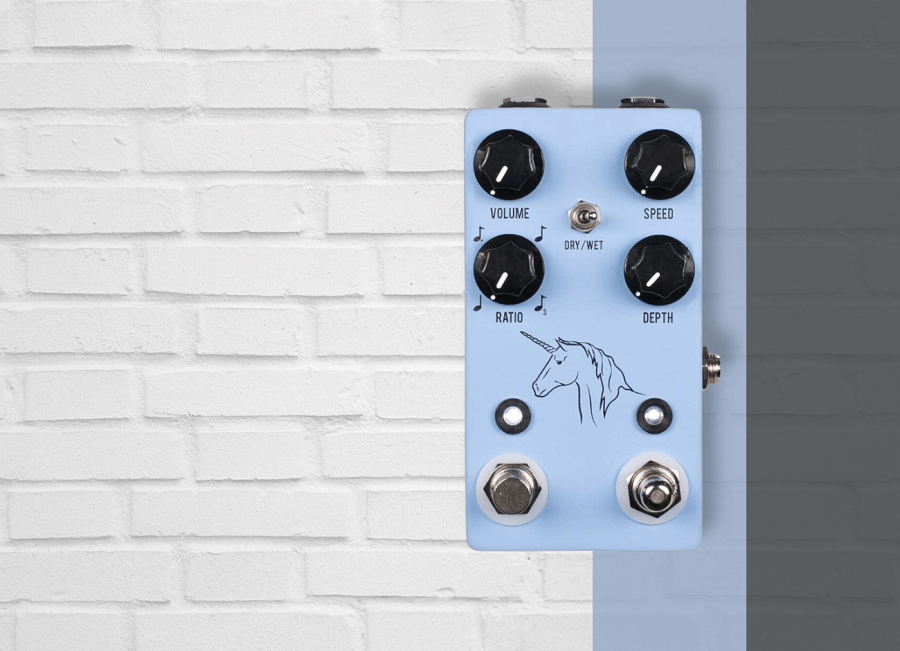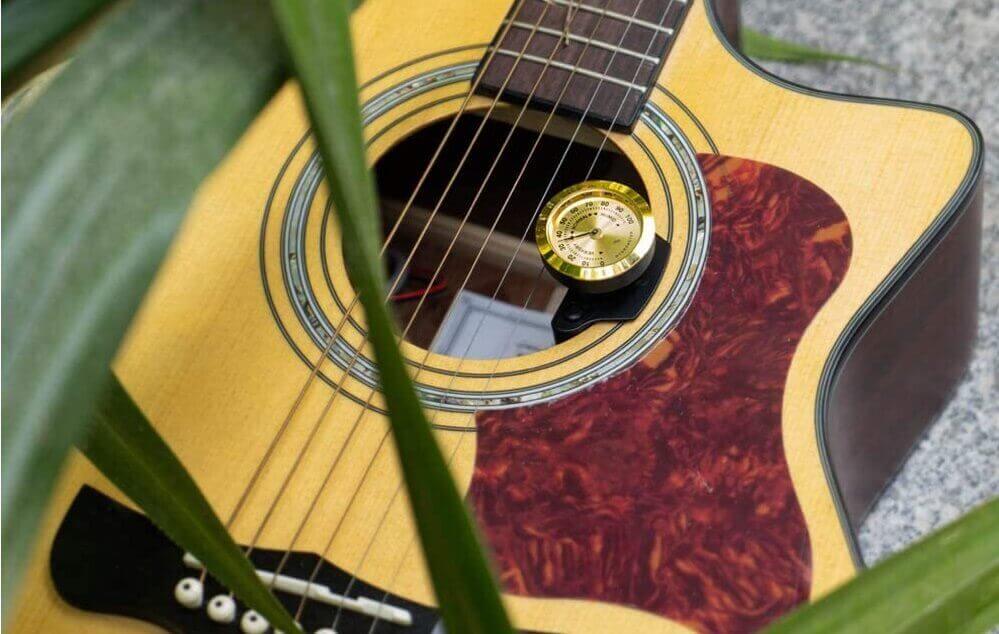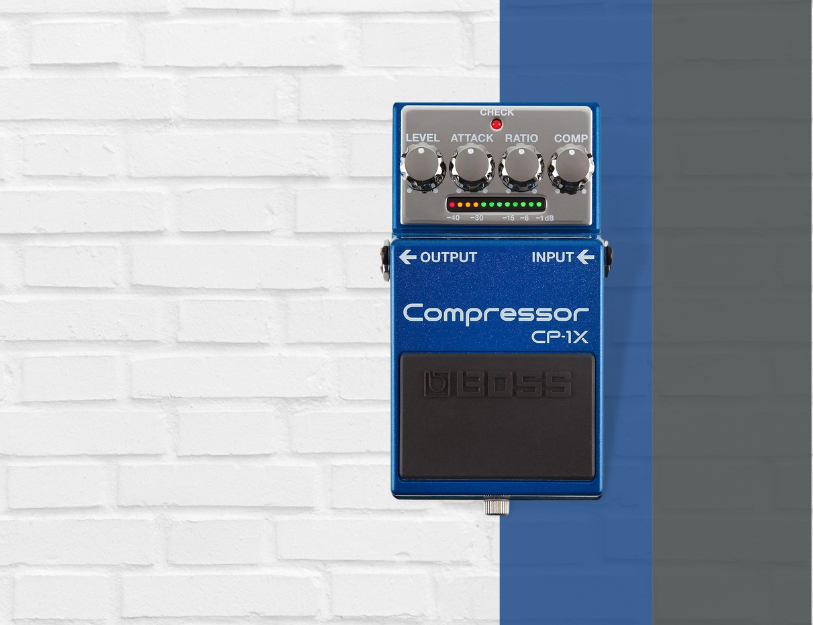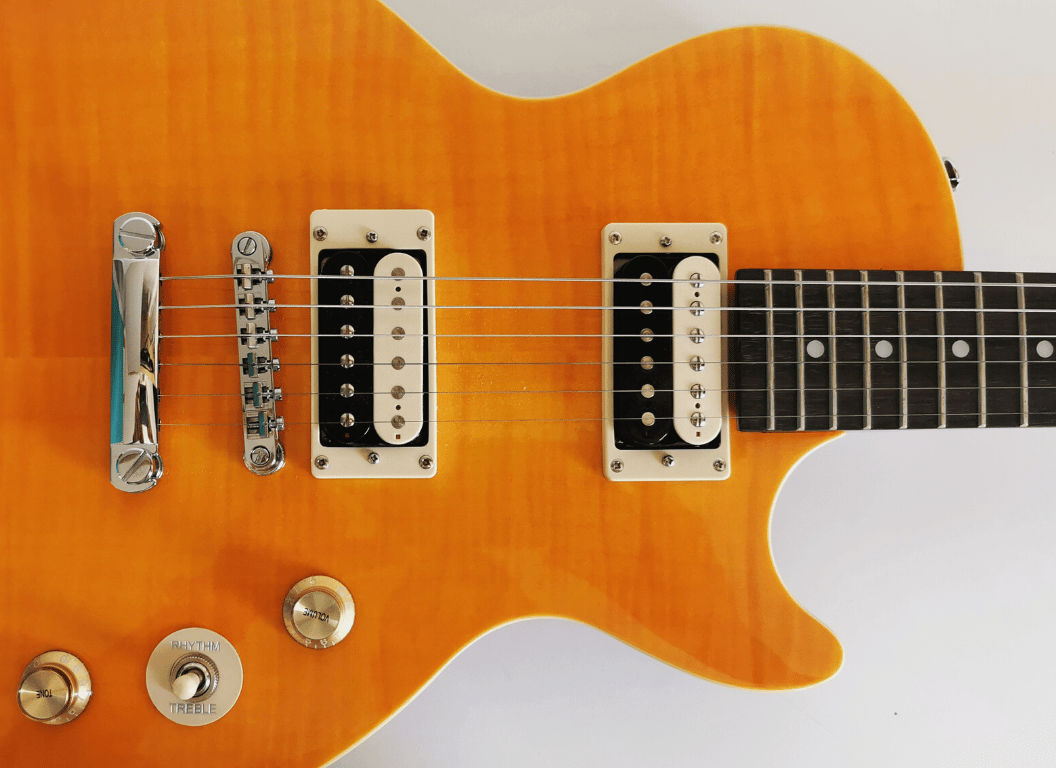Ever craved that hypnotic, swirling sound that seems to transport you straight back to the groovy ’60s?
Get ready to explore the world of the best univibe pedals that can assist you in achieving your desired sound…
Known for their distinctive phasing effect, univibe pedals have become an integral part of many a guitar player’s soundscapes.
These funky gadgets, originally developed as a Leslie rotating speaker simulator, have carved their niche, shaping the tone of countless memorable songs.
In this article, I aim to help you navigate the vast sea of options, showcasing top picks that precisely deliver that iconic swirl.
We’ll cover everything from budget-friendly gems to high-end marvels, providing the insights you need to find your perfect match.
Table of Contents
- Best Univibe Pedals
- What exactly is an univibe pedal?
- What to consider when choosing an univibe pedal?
- How to properly use an univibe pedal?
- – Familiarize yourself with the controls and features
- – Adjust the parameters to suit your musical goals
- – Incorporate the loop pedal into your signal chain
- – Experiment with different settings and combinations
- – Understand how the Univibe interacts with other pedals:
- – Use the Univibe pedal with an expression pedal:
- – Practice and refine your technique:
- How to order pedals on a pedalboard?
- Boutique vs. Mass-Produced pedals
- How much should you spend on a guitar pedal?
- Can you use a guitar pedal with a bass guitar?
- How to properly power your pedals?
Best Univibe Pedals
Before I begin, here are my top selected choices:
JHS Unicorn V2 Analog Univibe Pedal

Analog Uni-Vibe with Tap Tempo for inspiring modulation sounds. Check Price
|
|
Donner MOD Square Evolution Pedal

7 modulations, tap tempo, adjustable parameters, mini size. Check Price
|
DigiTech Ventura Vibe Pedal
Rotary/Vibrato pedal with three unique types, true stereo I/O, and high-voltage operation.
The Ventura Vibe Rotary/Vibrato pedal provides 3 unique rotary/vibrato effects with adjustable Tone and Drive controls. It features a foot-switchable speed function, stereo 1/4″ inputs/outputs, and a 9V DC power supply.
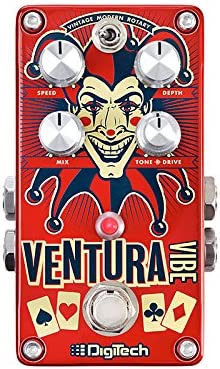
Let’s talk about the DigiTech Ventura Vibe Rotary/Vibrato Pedal.
This compact piece of kit offers guitarists a variety of unique sound effects inspired by both vintage and modern designs.
With options ranging from vintage uni-vibe style effects reminiscent of old-school phaser-based sounds to a pure pitch-based vibrato effect and even a rotary effect that imitates the distinctive Leslie speaker, this pedal provides a diverse range of tonal variations.
The Ventura Vibe boasts a vacuum-style footswitch with a soft click for ease of use, true stereo input/output, and true bypass circuitry to maintain your tone when bypassed.
In addition, this pedal’s high-voltage operation ensures an uncompromised signal quality for the best sound possible.
The pedal includes stage accessories like a stomp lock knob guard to secure your settings on stage and a custom-cut Hook and Loop Pedalboard Pad to affix your pedal securely to your pedalboard.
A nifty feature of this pedal is its foot-switchable speed function, allowing users to alternate between slow and fast speeds on the fly.
This deep red pedal, weighing in at 1 pound, is compact in design with dimensions of 4.4 x 2.6 x 2 inches.
Its compact size and eye-catching graphics make it a versatile and portable addition to any guitar gear setup.
Also, remember that it operates on a 9V DC power supply, making it easy to integrate into an existing pedalboard.
- My Review
After giving the DigiTech Ventura Vibe Rotary/Vibrato Pedal a spin, I’ve got to say it is quite a treat for the ears.
Its rich range of sound effects, with those alluring vintage and modern tones, take any performance up a notch.
Especially the uni-vibe effect truly revives that charming, old-school phaser feel that I thought was lost in time.
I appreciate how the design blends in both aesthetics and practicality.
It’s red color and captivating graphics lend a visual appeal that’s hard to ignore, while the compact size makes it an easily portable companion for any gig or jam session.
In addition, I was pleasantly surprised by the stomp lock feature and the custom-cut Hook and Loop Pedalboard Pad.
These thoughtful additions keep the pedal secured and settings intact, saving me from mid-performance fumbling.
The Ventura Vibe’s soft-click vacuum-style footswitch is a godsend.
It offers a smooth operation, effortlessly switching between slow and fast speeds while playing.
But what’s truly impressive is the true stereo input/output and true bypass circuitry.
Moreover, it maintains an uncompromised signal quality even when bypassed, delivering a superior sonic experience.
However, the product isn’t without its minor drawbacks.
Operating only on a 9V DC power supply can be limiting in certain situations.
A more flexible power option would have been a great inclusion.
And while the sound effects are wonderful, there might be a slight learning curve for beginners to utilize them fully.
So, does the DigiTech Ventura Vibe meet my expectations? Absolutely.
Here are the ratings I’ll give to the DigiTech Ventura Vibe Pedal:
Despite minor shortcomings, its versatility, ease of use, and excellent sound quality make it a fantastic asset to any guitarist’s arsenal.
It’s a pedal that lives up to the hype and then some.
- Pros:
- Works well at a lower price.
- Versatile with three unique rotary/vibrato types.
- Compact size and true stereo I/O.
- Includes useful stage accessories.
- Good value for the money.
- Cons:
- Lacks midrange when activated.
- Some settings may be too dramatic or muddy.
- Footswitch may not feel great or durable.
- Switching between modes may cause a slight delay.
- Not the most authentic univibe sound.
My final verdict is that the DigiTech Ventura Vibe Rotary/Vibrato Pedal Guitar-Multi-Effects is a highly versatile and feature-packed pedal that delivers a range of vintage and modern sounds.
Its compact size, true stereo I/O, and high-quality build offer great value for the money.
While it may have minor drawbacks, such as a slight lack of midrange and footswitch durability, it is a solid choice for guitarists seeking diverse modulation effects.
JHS Unicorn V2 Analog Univibe Pedal
Analog Uni-Vibe with Tap Tempo for inspiring modulation sounds.
The JHS Pedals Unicorn is an analog, photocell-based vibe effect with tap tempo, ratio, external tap control, and external rate control. Its unique features make it the first of its kind, allowing you to explore musical boundaries with unprecedented ease.
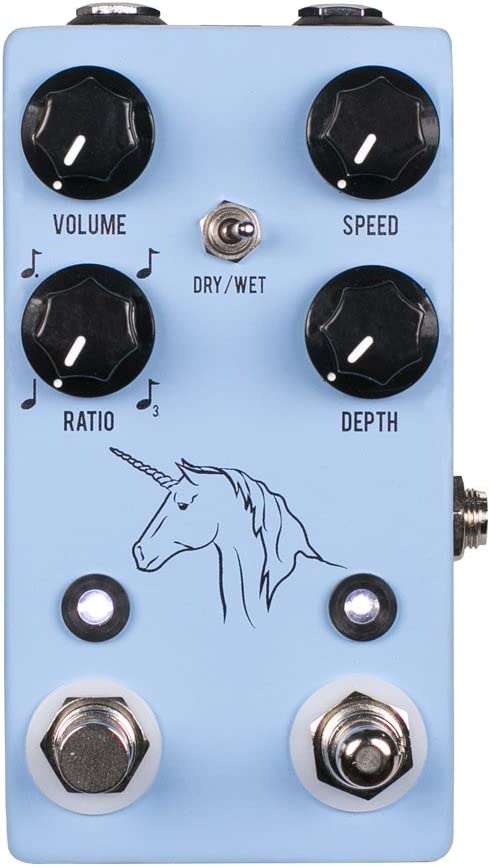
Taking a step into analog effects, the JHS Unicorn V2 stands out as an innovative guitar effects pedal.
It’s equipped with a unique photocell modulator and a tap tempo – an exciting combination you won’t find in many other pedals.
In addition, its entire signal path is analog, promising a warm, responsive tone that any guitarist can appreciate.
You’ll find a dry/wet toggle that allows you to switch between a Uni-Vibe effect and a more traditional Vibrato effect, granting you versatility for all your musical needs.
As for the control knobs, the pair on the left are designated for tone, while the ones on the right are for speed.
To top it off, this device runs on a standard 9V DC negative power supply.
With its 6 x 3 x 3 inches dimensions, this blue, compact pedal packs a punch in its innovative features while maintaining an appealing and sturdy design, suitable for every guitarist’s pedalboard.
- My Review
Taking a spin on the JHS Unicorn V2 Analog Univibe was quite an experience.
This pedal breaks new ground by being a photocell modulator coupled with tap tempo, all wrapped in a fully analog signal path.
Right out of the gate, I was struck by its warm, touch-sensitive tone, creating a genuinely interactive playing experience.
Playing around with the dry/wet toggle was fascinating – switching between a Uni-Vibe effect and a traditional Vibrato added a delightful versatility to my playing.
It offered more range and mood options for different styles and pieces, which is a big plus.
But the control layout caught my attention – the left pair for tone and the right duo for speed.
This gives you a lot of flexibility and invites you to dig deeper and shape your sound with rare precision.
While it’s an undeniable powerhouse, it isn’t without its flaws.
One peculiar issue that cropped up was a persistent throb along with the tap tempo, even when supposedly “off.”” As a result, iIt’s not a deal-break overall but something that could bother some players seeking absolute control.
Aesthetically, it’s a well-crafted device – compact and sturdy, with a visually appealing blue casing.
It’s about as practical as possible, fitting neatly on a pedalboard without taking up much space.
Its heft of 0.4 kilograms is light enough to carry around but substantial enough to feel reliable and durable.
Here are the ratings I’ll give to the JHS Unicorn V2 Analog Univibe Pedal:
Lastly, it’s worth noting that it’s a power-hungry beast, requiring a standard 9V DC negative power supply.
But considering the unique, versatile tone and capabilities it offers, I’d say it’s a small price to pay for such a sonic treat.
- Pros:
- Compact size and lightweight.
- Bright and versatile analog tones.
- Includes tap tempo feature.
- Flexible settings for subtle to heavy vibes.
- Well-made and durable construction.
- Cons:
- Possible quality control issues.
- Throbbing sound when tap tempo is off.
- Some units may experience defects.
- Potential compatibility issue with humbuckers.
My final verdict is that the JHS Unicorn V2 Analog Univibe with Tap Tempo Guitar Effects Pedal is a highly versatile and feature-rich pedal that delivers excellent analog tones.
It offers a compact size and lightweight design, making it convenient for pedalboards.
The tap tempo feature and flexible settings provide musicians with various options, from subtle to heavy vibes.
The brand, JHS Pedals, is known for its quality and craftsmanship.
While some reported quality control issues and compatibility concerns with humbuckers have been reported, this pedal’s overall performance and value are commendable.
Therefore, I would consider the JHS Unicorn V2 a solid choice for guitarists seeking a reliable analog vibe pedal.
MXR M-68 Uni-vibe Chorus Pedal
MXR Uni-Vibe Chorus/Vibrato–Lush, chewy textures in a smaller package.
The MXR Uni-Vibe Chorus/Vibrato offers a faithful recreation of the classic late ’60s effect in a modern, compact MXR housing. With three knobs, you can choose between Chorus and Vibrato modes and adjust speed, depth, and level.
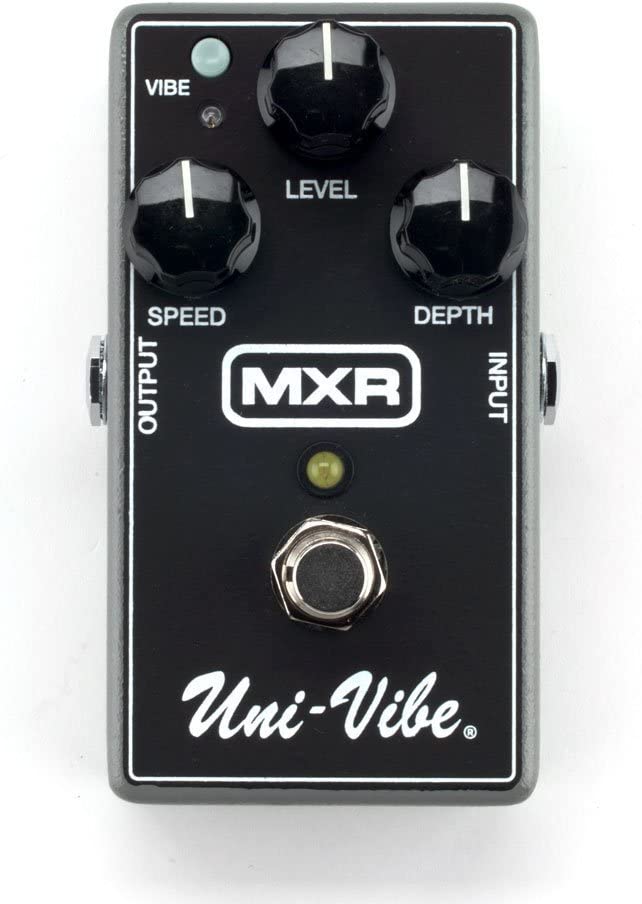
Introducing the MXR M-68 Uni-vibe, an innovative Chorus/Vibrato pedal revamped for today’s music scene.
The key to this pedal is its ability to produce thick, saturated textures that have been a music staple since the 1960s.
Despite its new compact design, it retains all the qualities that made its predecessor a classic.
Its housing, standard to MXR, has significantly reduced the original design’s size and weight.
One of the most notable upgrades is the addition of true bypass switching.
Setting up the sound you’re after with this pedal is a breeze, thanks to its straightforward, three-knob interface.
With a switch for selecting between Chorus Mode – a blend of dry and pitch-shifted signals, and Vibrato Mode – solely pitch-shifted signal, you have maximum control over your sound.
The LEVEL knob lets you adjust the volume of the effect, while the SPEED knob changes the sweep rate, and the DEPTH knob fine-tunes the overall intensity.
This pedal is a true gem for anyone looking to broaden their sound range.
- My Review
Plugging into the MXR M-68 Uni-Vibe Chorus/Vibrato pedal for the first time was a unique experience.
It’s apparent immediately that it brings that rich, full-bodied texture reminiscent of the late ’60s sound.
Its smaller, compact form makes it a breeze to fit on a crowded pedalboard, but don’t let its size fool you.
The power and depth of the tones it can produce are mind-blowing.
What struck me first was how intuitively the pedal responds.
Fiddling around with the three-knob interface, I found it effortless to sculpt the desired sound.
The VIBE switch toggles between Chorus and Vibrato modes, offering a tonal palette broad enough for any genre of music.
With just a few tweaks, you could be soaring through lush, chorus-infused landscapes or diving into the vibrato’s intense pitch-bending abyss.
Adjusting the LEVEL knob alters the effect volume, allowing you to blend the effect into your signal path precisely.
The SPEED control changes the sweep rate, offering a spectrum of rhythmic pulses from subtle waves to full-on sonic throbbing.
Finally, the DEPTH knob lets you control the overall intensity, which I found essential for fine-tuning.
Despite its numerous features, the MXR M-68 Uni-Vibe never feels overwhelming.
The true bypass switch ensures your dry signal remains unaffected when the pedal isn’t used, preserving your guitar’s natural tone.
The MXR M-68 isn’t just a recreation of a classic effect; it feels like a genuine evolution, respecting its heritage while pushing the boundaries of what a Chorus/Vibrato pedal can be.
Its 9-volt power requirement and 9-milliamp draw mean it’s easy to integrate into most setups.
Here are the ratings I’ll give to the MXR M-68 Uni-vibe Chorus Pedal:
It looks as good as it sounds in black, with a no-nonsense style that speaks to its professional performance.
All in all, this is a pedal that any tonal adventurer should seriously consider.
- Pros:
- Great Jimi Hendrix tone.
- Simple and easy to use.
- Compact and lightweight design.
- Cons:
- Limited customization options.
- May not suit all musical styles.
My final verdict is that the MXR M-68 Uni-vibe Chorus/Vibrato pedal is a solid choice for guitarists seeking to recreate the classic Jimi Hendrix tone.
With its simple and intuitive interface, compact design, and positive user reviews, it offers great versatility, features, and performance.
In addition, the MXR brand is known for its quality, and while the limited customization options may not suit all musical styles, the pedal provides excellent value for the price.
It is a reliable and capable chorus/vibrato pedal worth considering for guitarists looking to expand their tonal palette.
NUX Voodoo Vibe Mini Uni-vibe Pedal
Voodoo Vibe mini-Uni-vibe for versatile chorus/vibrato effects.
The Voodoo Vibe is a compact pedal that offers two vintage-style effects: Vibe and Chorus. It features a switchable mode and true bypass for authentic vintage sounds. Its small size makes it perfect for pedalboards and the easy-to-use controls provide a wide range of tones.
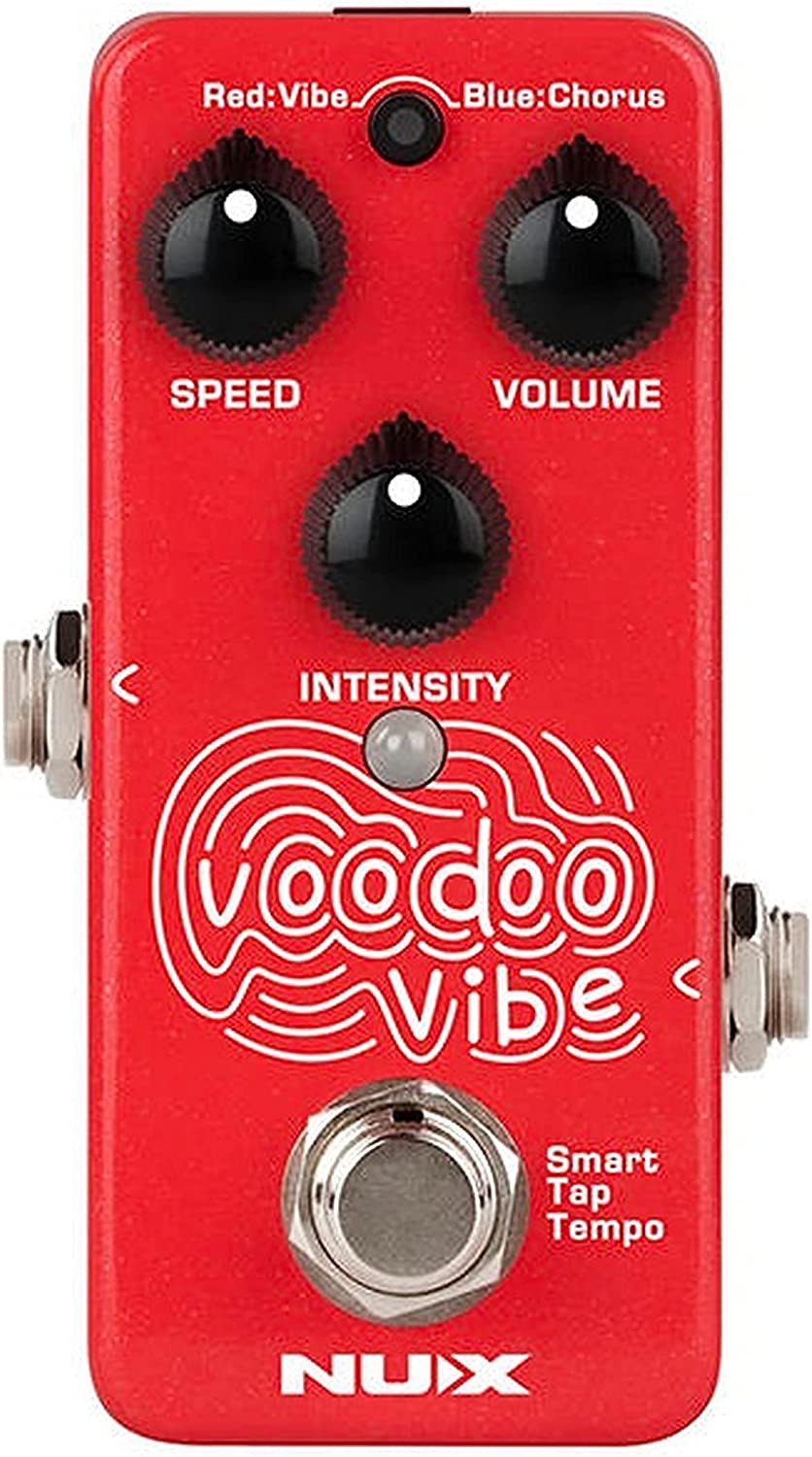
Housing two distinct modes in a compact package, the NUX Voodoo Vibe Mini Guitar Effects Pedal lives up to its name.
This mini-Uni-vibe pedal, known as the NCH-3, alternates between Vibe and Chorus modes, letting you explore different sonic landscapes.
You can effortlessly switch between these two effects with a simple press and hold of the footswitch.
In Chorus mode, the Intensity parameter adjusts the sweep effect’s depth, offering a lush, wide soundscape.
On the flip side, Vibrato mode provides a touch of pitch modulation – with the degree controlled by the Intensity setting.
Beyond these basic functions, the pedal boasts a Smart Tap Tempo feature, allowing you to set the speed of the effect with precision.
And depending on your signal chain needs, you can select True-bypass or Buffer-bypass (Tails) for a tailored sound output.
Running on 9 Volts and requiring only 50 milliamps, this analog pedal stands out in the NUX lineup.
- My Review
Stepping into the world of the NUX Voodoo Vibe Mini Uni-vibe Guitar Effects Pedal, it’s evident how this gadget makes a big impression in a compact package.
It doesn’t just promise variety; it genuinely delivers with its two modes – Vibe and Chorus.
Right off the bat, the Vibe mode is a solid favorite.
It yields a rich, luscious vibrato effect that can be pronounced without overwhelming the overall sound.
There’s just enough pitch modulation to add a layer of interest to your playing, and the depth of this effect is easily customizable thanks to the clever Intensity control.
Switching to the Chorus mode is a breeze, and here the pedal introduces a sweeping effect that feels like a generous wave of sound engulfing my tones.
It’s delightfully thick and full, proving the Voodoo Vibe isn’t just a one-trick pony.
But where this pedal shines is in its additional features.
The Smart Tap Tempo offers a level of control not often seen in pedals this size.
With a simple tap, I could dictate the tempo of the effects, shaping the rhythm of my performance with precision.
Even the options for signal bypass show thoughtful design.
For example, I could choose between True-bypass for a purer sound or Buffer-bypass (Tails) if I wanted the effect to linger a bit after disengaging the pedal, which adds an artistic touch to transitions.
Operating on 9 Volts and 50 milliamps, it’s not power-hungry and fits nicely into any pedalboard setup.
While its compactness might take some time to master the controls, it’s a small trade-off for such a portable and versatile pedal.
Here are the ratings I’ll give to the NUX Voodoo Vibe Mini Uni-vibe Pedal:
Yes, the Voodoo Vibe Mini is truly a force to be reckoned with in the realm of guitar effects pedals.
Its features, sound quality, and adaptability make it a valuable addition to any guitarist’s gear.
- Pros:
- Awesome thick lush vibe effect
- Small footprint
- Tap tempo functionality
- Cons:
- Limited control over depth/pitch modulation
- May require additional power supply
My final verdict is that the NUX Voodoo Vibe Mini Uni-vibe Guitar Effects Pedal is a versatile and feature-rich pedal with excellent tone and performance.
The NUX brand has a positive reputation; considering its value, this pedal seems to offer a great deal.
However, it is important to note that it may be challenging to assess potential drawbacks accurately without any negative reviews available.
Based on the provided information, the NUX Voodoo Vibe Mini Uni-vibe Guitar Effects Pedal is a solid choice for guitarists seeking a compact and capable modulation pedal.
Donner MOD Square Evolution Pedal
7 modulations, tap tempo, adjustable parameters, mini size.
Donner MOD Square Evolution+ is a 7-mode mini digital modulation pedal with Tap Tempo, allowing you to adjust effect speed instantly and create the perfect sound for any genre. It features wide-ranged effect controls, providing a variety of tones and versatile sonic textures. It is light weight and compact-sized, perfect for any pedalboard.
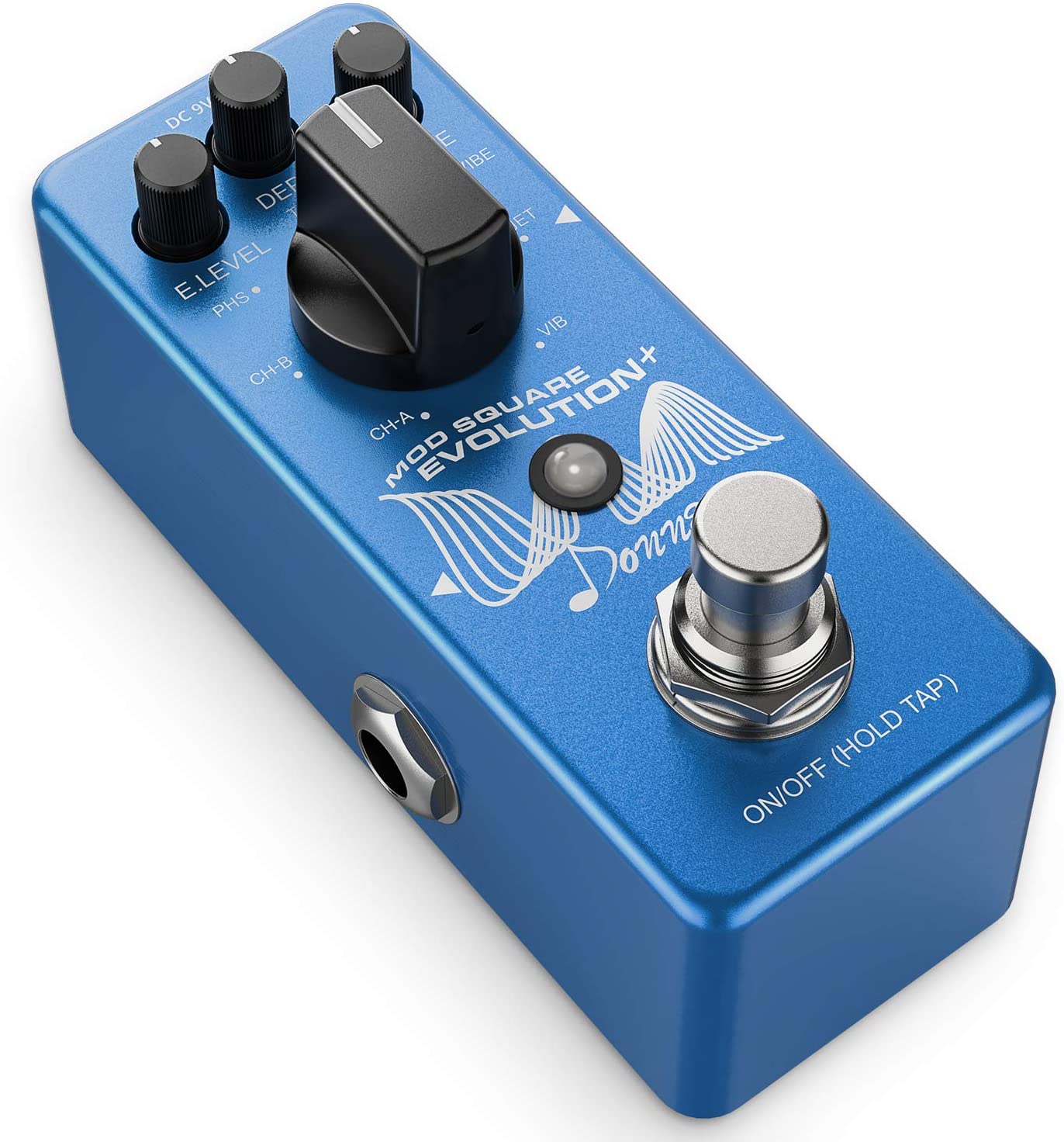
The Donner MOD Square Evolution Pedal, a guitarist’s dream, it’s a versatile piece of equipment that presents seven functional modulation effects in a single compact unit.
It offers classic effects like chorus, flanger, and phaser and comes with tremolo, vibrato, rotary, and auto-wah options, giving a wide array of sound possibilities.
Compact and sturdy, the MOD Square Evolution Pedal’s body is constructed from robust aluminum alloy, designed for longevity and resistance to wear.
Its easy-to-read interface has three knobs for controlling level, depth, and rate, allowing sound customization with precision.
True bypass provides a transparent tone, ensuring no loss in quality when the pedal is off, which is a great feature for those valuing pure signal flow.
Don’t forget; it’s an excellent choice for those wanting variety without sacrificing pedalboard space.
Powered by a standard 9V (negative in the center), you’ll find it fitting in your setup seamlessly.
- My Review
Diving headfirst into my experience with the Donner MOD Square Evolution Pedal, I was immediately taken by its robust design.
Composed of solid aluminum alloy, it looks and feels sturdy, suggesting it could handle the rigors of regular gigging without missing a beat.
Switching it on, I was pleasantly surprised by its sound diversity.
You do not come across seven distinct modulation effects squeezed into one small box daily.
Each effect, whether it’s chorus, flanger, phaser, tremolo, vibrato, rotary, or auto-wah, has a unique voice that genuinely enhances my playing.
Controlling these effects, I found, is straightforward.
The three knobs for level, depth, and rate allow precise adjustment.
Notably, the rotary effect delivered a stunning Leslie-like sound that left me a bit nostalgic for my old, bulky rotary speaker.
Likewise, the auto-wah effect served up funky tones that instantly took me back to the 70s.
Yet, it’s important to note that the vibrato effect seemed slightly weaker than the others.
So it wasn’t necessarily a deal-breaker, but something that could potentially use a bit of a boost in future iterations of the pedal.
What truly impressed me, though, was the pedal’s true bypass feature.
When the pedal is not used, it doesn’t color my tone, maintaining the guitar’s original sound fidelity.
And for those conscious about conserving pedalboard real estate, its compact size is a big plus.
I faced no issues running the pedal with a standard 9V power supply.
It integrated seamlessly into my rig, suggesting it would do the same for anyone else.
Here are the ratings I’ll give to the Donner MOD Square Evolution Pedal:
So, having spent quality time with the Donner MOD Square Evolution Pedal, it’s safe to say it delivers a high level of versatility and sound quality.
Despite the slight hiccup with the vibrato, it won me over and proved a valuable addition to my gear.
- Pros:
- Compact size for easy portability
- Offers 7 modulation effects in one pedal
- Tap Tempo function for instant speed control
- Wide tonal range suitable for different music genres
- Cons:
- Some effects may sound muddy or lack definition
- Cannot use multiple effects simultaneously
- Possible drop in tone and volume
My final verdict is that the Donner MOD Square Evolution+ Guitar Effects Pedal offers a compact and versatile solution for adding modulation effects to your music.
With its wide range of modulations and convenient tap tempo function, it provides ample features for experimentation.
While some users have noted limitations in tone and simultaneous effect usage, overall, it offers good value for its price.
Considering its versatility, features, performance, and brand reputation, I recommend the Donner MOD Square Evolution+ as a suitable option for musicians seeking an affordable and compact modulation pedal.
Valeton Coral Mod II Digital Modulation Pedal
Versatile, multi-modulation pedal with easy tempo control.
The EMG T System offers a bright, responsive, and virtually noiseless tone with easy solderless installation, making it perfect for upgrading Telecaster-style guitars. The kit includes pre-wired components and helpful diagrams for a hassle-free setup.
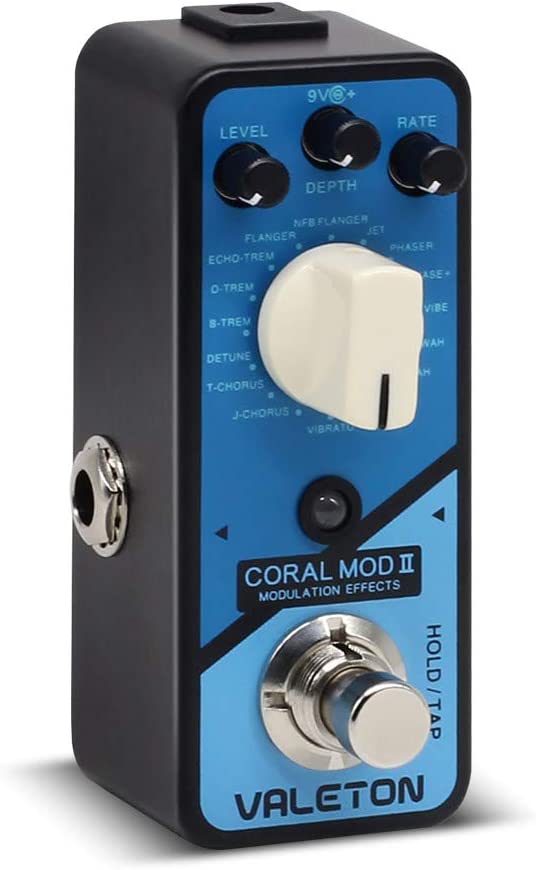
Meet the Valeton Coral Mod II – a versatile multi-effects pedal tailor-made for both guitar and bass.
This compact, handy device has 16 distinctive modulation algorithms, each meticulously crafted to cater to various musical styles.
From providing the utility of a portable mini-pedal to an adventurous palette of sound-modifying options, it’s more than just a space-saving choice.
In addition, you can use the built-in tap tempo function for precise real-time control over the speed of your effects.
Designed with a specialized buffer bypass circuit, it maintains the integrity of your original tone.
This pedal operates with a 9V center negative power supply.
Coming in blue and black hues, it operates at a voltage of 9V with 100 milliamps amperage.
This pedal covers all the modulation staples, from flangers and phasers to the unique Lofi effect.
Valeton, a known brand for quality, presents this modulation pedal in a stylish design that boasts both utility and sophistication.
- My Review
My experience with the Valeton Coral Mod II Digital Modulation Pedal has been interesting.
Unboxing it, I was immediately struck by its compact yet sturdy design.
Its aluminum alloy casing is built to last, promising durability for those long gig nights.
Tinkering around, I was pleased to discover the dual footswitch system – an intuitive feature that allows quick toggling between effects, a real-time-saver during live performances.
The pedal’s incorporation of an OLED screen, too, makes navigation a breeze.
With a glance, you know exactly which effect you’re currently using, reducing potential confusion on a dark stage.
Now, let’s talk about the sound.
With sixteen modulation algorithms, this pedal can take you on a sonic journey.
I found each effect to be of excellent quality and true to the original sounds they mimic.
From classic tremolo to modern bit-crushing, each effect was distinctive, dynamic, and rich in texture.
However, there was a bit of a learning curve when it came to tweaking the parameters.
With such a vast array of effects, figuring out the ideal settings for each took some time.
But that’s part of the fun, right?
Exploring, discovering, and crafting your unique sound.
Despite that, there’s something that could use some improvement – the instruction manual.
A little more detail wouldn’t hurt, especially for beginners just getting their feet wet in the modulation world.
In my experience, the Valeton Coral Mod II proved to be a versatile and high-quality pedal.
Here are the ratings I’ll give to the Valeton Coral Mod II Digital Modulation Pedal:
It brings a robust build, sound variety, and practical design to the table, making it a worthy addition to any musician’s gear lineup.
Sure, it’s not without quirks, but what gear is it?
- Pros:
- Wide variety of modulation effects
- Good value for the price
- Compact and portable
- Positive customer reviews
- Cons:
- Some effects may sound muddy
- Reports of occasional malfunctions
- Controls can be fidgety
My final verdict is that the Valeton Coral Mod II Digital Modulation Chorus Flanger Phaser Univibe Tremolo Lofi Multi-Effects Guitar Bass Pedal is a versatile and feature-rich pedal that offers a wide range of modulation effects.
While it may not excel in every aspect, it provides good performance and value for the price.
However, there have been reports of occasional malfunctions and fidgety controls, which should be considered.
It is a solid choice for musicians seeking a compact, affordable multi-effects pedal.
TC Electronic Viscous Vibe Guitar Pedal
Recreates legendary Uni-Vibe tones superbly.
Experience the iconic sound of the Shin-Ei Uni-Vibe in a compact, modern pedal. Customize it with free TonePrint editor and true bypass for uncompromised tonal quality. Users admire its exceptional tones, versatility, and value, though some report operational quirks and fragility in the switch system..
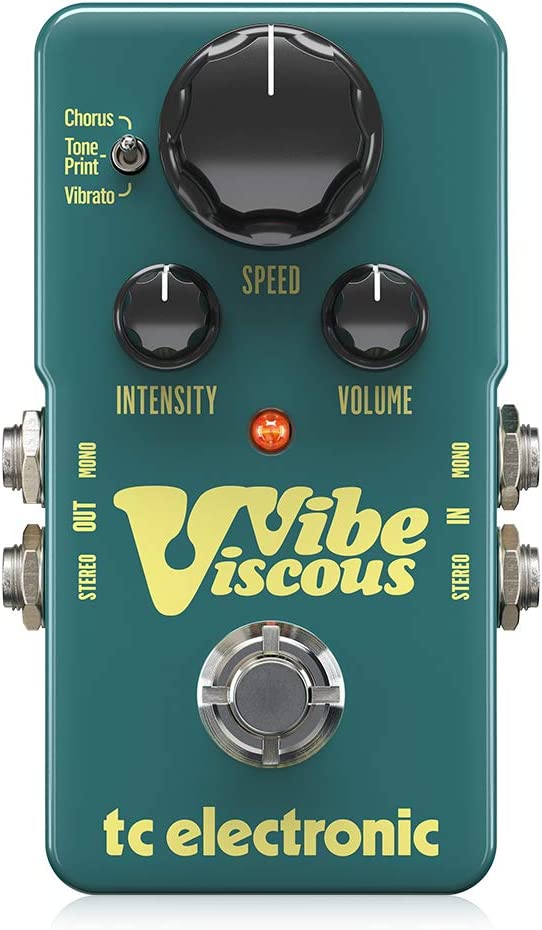
The TC Electronic VISCOUS VIBE is a compact yet powerful guitar pedal that brings back the legendary Shin-Ei Uni-Vibe sound in a highly functional design.
Altering between vintage and modern tones, the pedal offers a wide sonic palette for guitarists with its TonePrint technology.
Featuring an assortment of colors and a sleek 5 x 3 x 3.31 inches size, the VISCOUS VIBE is pleasing to the eye and handy on a packed pedalboard.
It retains the best qualities of the original Uni-Vibe in a digital format while ensuring classic analog warmth and depth.
One standout aspect of this pedal is its compatibility with the TonePrint app, allowing you to beam artist-designed or customizable vibe effects directly into the pedal.
Moreover, its true stereo I/O lends added dimension to your sound, and you can choose between true or buffered bypass modes according to your preference.
Finally, the pedal’s innovative design ensures that your dry signal remains untouched and in pure analog form with the Analog-Dry-Through feature.
- My Review
I’ve had the pleasure of trying out the TC Electronic VISCOUS VIBE pedal, and I must say, it’s genuinely impressive.
Featuring both the legendary Shin-Ei Uni-Vibe sound and a modern design in a compact package, this pedal truly offers guitarists an extraordinary experience.
Now, let’s talk about the brand itself.
TC Electronic is known for its superbly designed pedals and attention to detail, and the VISCOUS VIBE is no exception!
However, what initially struck me is how versatile the pedal is with implementing TonePrint technology.
Not only do you get those lush, convincing vibe tones, but you can also customize and instantly “beam” your settings through the TonePrint app.
The opportunity to experiment with various vibe effects and artist-designed presets brings a whole new level of personalization to your guitar sound.
Performance-wise, the VISCOUS VIBE captures the vibrant tones reminiscent of artists like Pink Floyd, Robin Trower, and Jimi Hendrix.
For example, when using it in the classic Hendrix Vibe setting, it easily delivers that slow speed, high-intensity swirl.
I also love that it recreates the signature watery and tape-delay-like modulation right out of the box.
The pedal offers optional true or buffered bypass for optimal tonal clarity, and the true stereo I/O gives the effect an expansive, three-dimensional quality reminiscent of analog warmth.
However, it does have a couple of drawbacks.
First, when the pedal offs take around 2-3 seconds to disengage, which can be a nuisance mid-performance.
Here are the ratings I’ll give to the TC Electronic Viscous Vibe Guitar Pedal:
Also, the tactile switch falls short in terms of long-term durability and may hinder players who rely heavily on the pedal.
Despite these minor setbacks, the TC Electronic VISCOUS VIBE is a fantastic addition to any guitarist’s pedalboard who wishes to explore eclectic vibe tones in a modern and compact unit.
- Pros:
- Authentic Shin-Ei Uni-Vibe recreation.
- Customizable with TonePrint technology.
- Compact and reasonably priced.
- Cons:
- Delay when disengaging pedal.
- Possible long-term switch durability issues.
- Minor operational quirks.
My final verdict is that the TC Electronic VISCOUS VIBE pedal is a well-rounded and versatile piece of gear, perfect for capturing those iconic Shin-Ei Uni-Vibe sounds.
With a nice combination of customizable features, stellar tone quality, and a dependable brand reputation, it offers excellent value for its price.
Despite its drawbacks, this pedal deserves a spot in any guitarist’s pedalboard.
What exactly is an univibe pedal?
The Uni-Vibe, a uniquely styled guitar effects pedal, has firmly established its place in rock and roll history with its singular tone, an amalgamation of phasing, chorus, and vibrato effects.
With its roots firmly embedded in the psychedelic sounds of the late 1960s and early 1970s, the Uni-Vibe has become a classic piece of equipment cherished and pursued by vintage gear enthusiasts and modern players.
The Uni-Vibe was originally conceived and manufactured by Shin-ei in the late 1960s.
Designed to emulate the undulating, swirling sound of a Leslie rotating speaker cabinet, the Uni-Vibe achieved a decidedly different but no less desirable result.

It created a complex, organic sound, quickly adopted by many influential guitarists of the era, including Jimi Hendrix and Robin Trower, who utilized it to shape their distinctive sounds.
The most iconic use of a Uni-Vibe was arguably on Hendrix’s live rendition of “Machine Gun” at the Fillmore East.
Physically, the original Uni-Vibe was a relatively large unit with a companion foot pedal for adjusting the effect’s speed.
A series of discrete electronic components created the effect inside the pedal through a bulb-and-LDR (Light Dependent Resistor) design.
A small light bulb inside the unit would vary its brightness, and four photo-resistors were changing their resistance based on the light level.
This simple yet elegant design was responsible for the Uni-Vibe’s rich and organic modulation characteristic.
A defining feature of the Uni-Vibe pedal is its set of controls: a switch to choose between chorus (a more intense, full effect) and vibrato (a simpler, pitch modulation effect), and knobs for “intensity” (depth of the effect) and “speed” (rate of the modulation).
The foot controller typically adjusts the speed, allowing real-time manipulation during performances.
The interface offers straightforward access to a wide range of tones, from subtle, pulsating modulation to wild, psychedelic swirls.
Modern incarnations of the Uni-Vibe, made by manufacturers like MXR, TC Electronic, and Fulltone, have adapted the design for the more pedalboard-friendly stompbox format, and some have also added true bypass switching and LED rate indicators.
Yet, they all aspire to capture the unmistakable sonic magic of the original.
At the heart of the Uni-Vibe’s allure is its sound.
More than just a simple phaser, chorus, or vibrato, the Uni-Vibe imparts a liquid, pulsating modulation that seems to breathe with a life of its own.
It can add a subtle, undulating movement to clean guitar tones or transform a distorted tone into a thick, swirling mass of sound.
While it has a character all its own, it’s also incredibly interactive, responding to changes in the guitar’s volume, tone settings, and the player’s touch.
Moreover, the Uni-Vibe has an almost chameleonic quality.
In a band mix, it can help a guitar part stand out, or blend in, depending on how it’s used.
At lower speed and intensity settings, it can add a warm, slightly detuned quality that enhances a guitar’s natural tone without overwhelming it.
Cranked up, it produces a wild, whirling effect perfect for solos or psychedelic freakouts.
What to consider when choosing an univibe pedal?
When choosing an Univibe pedal for your guitar setup, it is essential to understand the factors that play a vital role in shaping your sound.
The Univibe pedal was originally designed to simulate the sound and feel of a rotary speaker cabinet.
Over the years, the pedal has become a staple of many guitarists, most notably Jimi Hendrix and David Gilmour.
Here is a breakdown of the crucial elements to consider when choosing the perfect Univibe pedal:
– Sound quality
The most crucial factor to consider when looking for an Univibe pedal is its sound quality.
Start by analyzing the effect’s depth and clarity to understand how it will impact your sound.
Does the pedal provide a lush and rich modulation, or is it thin and weak?
The texture and tonal quality of the sound will significantly depend on your preferences, playing style, and the style of music you intend to play.
It is also essential to notice the pedal’s responsiveness.
A good Univibe should be sensitive to your playing dynamics and respond accurately to your picking and volume adjustments.
When used properly, a quality Univibe pedal will add another layer of expressiveness to your playing.
– Controls and features
Take a closer look at the available knob adjustments and features of the pedal.
While many presets will provide appealing Univibe effects, finding a pedal with at least essential tweaking capabilities is key.
Univibe pedals typically come with at least three adjustment knobs: speed (or rate), intensity (or depth), and volume (or level).
Additional parameters and options for more control over the modulation effect, such as waveform shape or tone knobs, can be desirable.
Features like the ability to switch between vibrato or chorus modes, tap-tempo input, and expression pedal control can all drastically increase your ability to tailor the pedal’s effect to your specific needs and add extra flexibility during performances.
– Analog vs. Digital
The debate between analog vs. digital effects may ultimately be personal preference.
Due to their circuitry design, Analog pedals are often favored for their organic and warm sound character.
However, analog Univibe pedals can sometimes result in signal coloration, which may or may not be appealing to you.
On the other hand, digital pedals can offer increased sound-shaping capabilities because they are modeled after the sonic characteristics of certain circuits or devices.
In addition, technological advancements have made digital effects strongly robust and versatile.
However, true analog enthusiasts often argue that digital effects will faithfully replicate certain nuanced elements of the effect sound.
So, regarding analog vs. digital, trial and error will help you find the best option.
– Build quality and durability

Regardless of your playing habits or the intensity of your performances, investing in an Univibe pedal built for reliable use is crucial.
Durability depends on materials, quality, overall design, and safety features.
Check the connections’ strength and rigidity, ensuring the jacks and knobs are high quality and securely in place.
A well-protected, sturdy metal casing can provide extra security against inevitable bumps and collisions.
– Presets and versatility
Though classic Univibe pedals are primarily known for their modulating, phase-like vibes, having a pedal that offers different presets, or alternate effect options is beneficial.
Consider your needs as a musician and search for a pedal that provides diverse effects while still maintaining the essential Univibe essence.
Multiple modulation types, expandable settings, and varying sonic characteristics can help you find new inspiration and employ them creatively in your music.
– Brand reputation
A simple way to reassure yourself of a pedal’s credibility is by looking at the brand behind it.
Companies with a proven track record are likelier to produce reliable, high-quality products.
However, this does not disqualify newer or smaller brands from the competition.

Each individual’s requirements are subjective; therefore, remind yourself that recommendations from others might not necessarily fit with your unique preferences.
Still, it would be best if you explored options from established manufacturers while being open to emerging industry-related brands to ensure the best chances of finding the right product.
– Price and budget
Of course, price and budget play a substantial role in choosing any guitar effect pedal, and Univibe pedals are no exception.
To determine the maximum budget you can comfortably afford, begin your search within this range.
Remember that while the cheapest options might be tempting, they may sacrifice overall quality.
This applies to both sound quality and material quality.
Conversely, an expensive option may provide all the bells and whistles, but you could overpay for added features you might never touch.
Find options within your budget that cover the essential criteria mentioned earlier without sacrificing what’s most important to you.
– Reviews and recommendations
The final step in choosing an univibe pedal is contacting friends, online forums, and trusted reviews from reputable sources.
User experiences always help provide a clearer understanding of the product’s strengths and weaknesses.
You should also visit your local guitar store to test the available Univibe options.
The overall effect you derive from a particular pedal may help finalize your decision.
How to properly use an univibe pedal?
As a guitarist, you might have access to an array of guitar effects pedals to help enhance your sound and add some extra character to your setup.
One such classic guitar pedal, which numerous influential players have used, is the Univibe pedal.
Made famous by artists such as Jimi Hendrix and David Gilmour, the Univibe pedal adds a distinctive swirling and vibrato-like effect to your sound.
Here, we will discuss how to properly use a Univibe pedal to maximize its potential and achieve outstanding results every time.
– Familiarize yourself with the controls and features
Before plugging into your Univibe pedal and exploring its capabilities, it is vital to understand its ins and outs.
The Univibe pedal typically consists of a few essential components, making it a powerful yet straightforward unit.
These components include:
- Intensity: This knob controls the intensity or depth of the effect, essentially adjusting how dramatic you wish the swirling sounds to be.
- Volume: This adjusts the overall output level of the pedal—a crucial control for balancing your overall guitar sound and effect balance when using multiple pedals.
- Speed: Controlling the pulse speed of the effect, the speed knob dictates how fast or slow the intensity modulation moves, altering the choppiness of the effect.
- Throb/Focus: Found on some high-end Univibe models, this control helps to adjust the balance between the effect’s low-frequency content and the guitar signal.
- Mode switch: This feature allows you to switch between a Univibe mode (chorus) and a somewhat more subtle vibrato mode.
- Footswitch: This pedal switch lets you control the Univibe effect onset/vibration by tapping it with your foot.
By understanding these controls, you can precisely adjust your Univibe to produce the desired swirling effect on your guitar sound.
– Adjust the parameters to suit your musical goals
Balancing your pedal goals comes down to adjusting the Intensity, Volume, and Speed controls to your liking.
More subtle adjustments are made according to your taste, fine-tuning rates at which you incorporate the Univibe effect throughout your performance.
For example, you may want a slower and deeper modulating sound for sadder or chilled tunes, whereas more energetic performances may call for higher intensity and faster, more twitchy modulation.
Determine the types of songs you plan to play and experiment to find your desired sound.
– Incorporate the loop pedal into your signal chain
Univibe pedals work best with a clean or slightly overdriven signal.
Therefore, place the Univibe early in the signal chain, ideally after the tuner pedal but before the overdrive or distortion pedals.
This placement ensures that the effect modulation transmits clearly through the rest of your signal chain and avoids too much signal degradation.
– Experiment with different settings and combinations
One of the Univibe’s biggest charms is its interaction with other pedals.
Its effect multiplies and evolves when used with overdrive and distortion pedals; it can create a different sonic texture with a wah or delay pedals.
By experimenting, you can unlock the vintage swirling sounds that made the Univibe pedal famous.
Instance successes may come from pairing it with conventional overdrive, fuzz, or distortion pedals, as used by Hendrix.
Combining Univibe with other modulation effects can produce more creative or experimental edge sounds to push the sonic boundaries.
– Understand how the Univibe interacts with other pedals:
To properly use the Univibe, you should know how it might alter your tone or interact with other pedals within your chain.
For example, consider the impact of having an Univibe effect running while using an overdrive pedal, fuzz, or other modulation effects like tremolo.
Considering which phases and intensities are appropriate depending on the physical space and tonal quality can be crucial.
Doing so lets you thoughtfully enhance live performances and precisely tailor your guitar sound.
– Use the Univibe pedal with an expression pedal:
Many modern Univibe pedals have an expression pedal input, gradually controlling the Univibe’s effect intensity or speed with foot control.
Rather than a simple on/off switch or modifying settings on the fly, you are offered a more deliberate and dynamic swirling modulation by integrating an expression pedal.
By controlling the Univibe with an expression pedal, you retain your hands-free to play guitar while still manipulating the effect.
– Practice and refine your technique:
Like any piece of equipment in a musician’s arsenal, a pedal is only as good as the person using it.
With enough comfortability, you create a signature texture around your playing, blending in the modulating nuances as they come.
Rather than deploying the Univibe during particular sections of songs, you will learn to fade it lightly, adjusting its settings to nuance rather than interrupt.
Patience is essential to understand how these textures can impact performances for the better.
With time and proper practice, using your Univibe will become second nature.
How to order pedals on a pedalboard?
There is no one-size-fits-all approach to ordering pedals on a pedalboard, as the optimal arrangement largely depends on the specific sound you’re aiming for.
Usually, though, you will see guitar players mostly agreeing with this order:
Tuner > Filters/Dynamics > Pitch-based Effects > Overdrive/Distortion > Modulation > Time-based Effects > Looper
Aside from that, some general guidelines can help you achieve a balanced and versatile setup.
Let’s talk in detail about the order we just mentioned, but feel free to experiment and adjust to your own preferences:
- Tuner: Place your tuner pedal first to ensure your signal is in tune before passing through the other pedals.
- Filters and dynamics: Wah-wah, envelope filters, compressors, EQs, and noise gates should come next. These pedals affect your sound’s dynamic and tonal aspects, so it’s best to place them early in the chain.
- Pitch-based effects: Octavers, harmonizers, and pitch shifters should come after filters and dynamics since these pedals alter the pitch of your signal and work best with a clean, unprocessed sound.
- Overdrive and distortion: Overdrive, distortion, and fuzz pedals typically come next. They shape your guitar’s core sound, and placing them before most other effects ensures that those effects receive a strong, consistent signal.
- Modulation effects: Chorus, flanger, phaser, and tremolo pedals should be placed after overdrive and distortion effects. We do this to allow these pedals to add depth and movement to your sound without becoming overly distorted or overbearing.
- Time-based effects: Delay and reverb pedals should be placed towards the end of your signal chain. This allows them to create a sense of space and depth around the other effects, simulating the sound of a room or hall.
- Looper: If you use a looper pedal, it should be placed last in the chain. This ensures that you’re looping the entire signal, including all the effects you’ve applied.
Remember, these are just general guidelines and what generally works and sounds good.
The most important thing is to experiment and find the arrangement that best suits your personal sound and style.
For example, here’s one pedalboard signal chain that I always use:
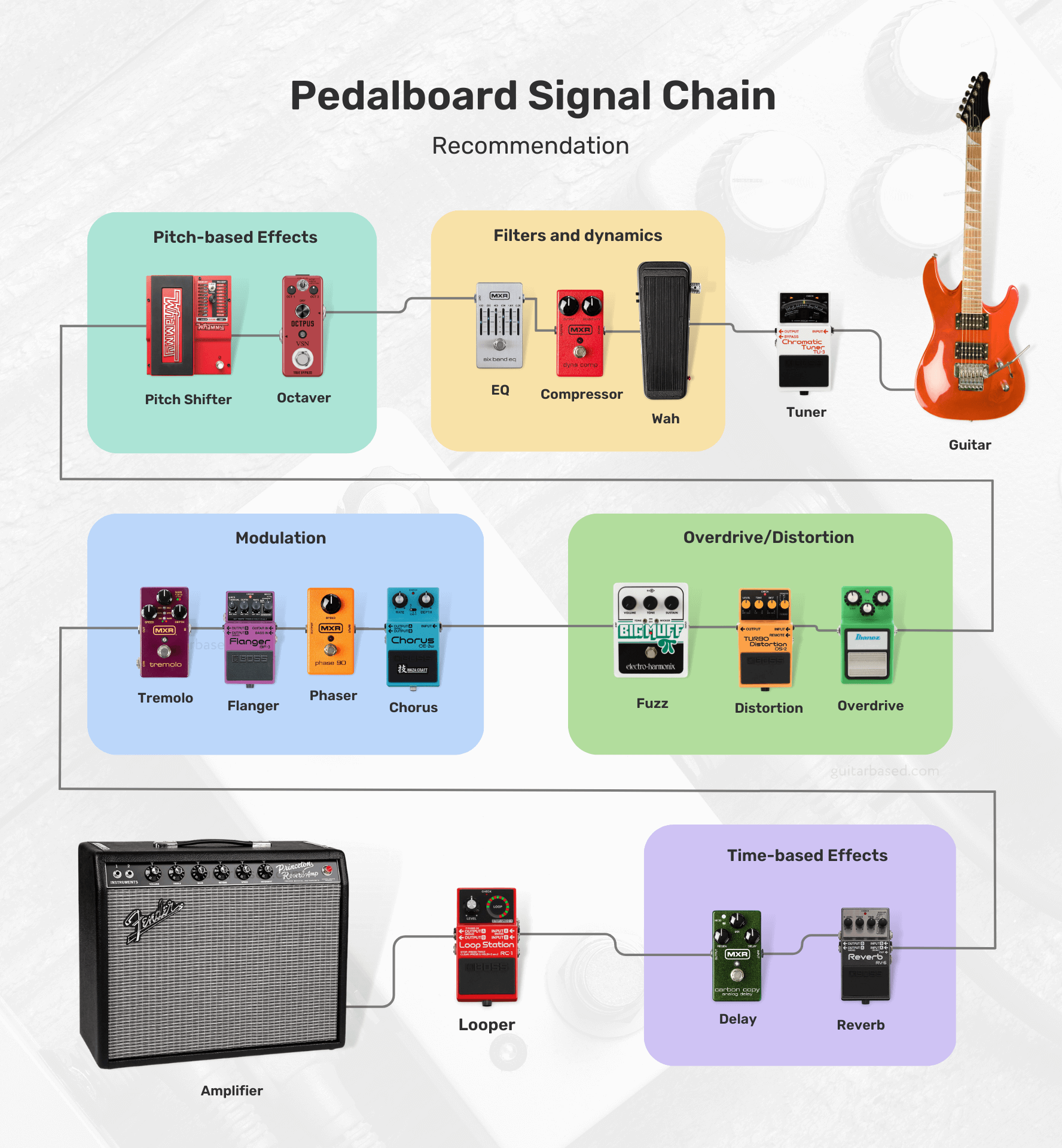
Feel free to swap the order of pedals, try different combinations, and test out unconventional setups until you find the one that works best for you.
For those interested, I’ll leave you with most of the possibilities that you’ll encounter and how to order them.
- Tuner
- Filters/Dynamics:
- Volume
- Wah
- Auto-Wah
- Compressor
- Noise Gate
- EQ (Equalizer)
- Pitch-based Effects:
- Octaver
- Harmonizer
- Pitch Shifter
- Overdrive/Distortion/Fuzz:
- Boost
- Overdrive
- Distortion
- Fuzz
- Modulation:
- Chorus
- Phaser
- Flanger
- Univibe
- Vibrato
- Tremolo
- Time-based Effects:
- Delay
- Echo
- Reverb
- Synth/Bitcrusher:
- Synth
- Bitcrusher
- Acoustic Simulator
- Multi-Effects
- Utility:
- Buffer
- A/B/Y Switcher
- MIDI Controllers
- Looper
Boutique vs. Mass-Produced pedals
Boutique pedals are generally built with higher-quality components and craftsmanship, resulting in better durability and longevity.
These pedals often feature unique and innovative designs, providing a wider range of tones and effects that may not be available in mass-produced options.
Here are a few examples of boutique pedals:

All the manufacturers also tend to have a more personal approach, with better customer service and the ability to customize pedals according to the user’s preferences.
However, boutique pedals are usually more expensive due to the smaller scale of production and the use of premium components.
Mass-produced pedals, on the other hand, are more affordable due to their larger scale of production and the use of cost-effective components.
These pedals are widely available and offer a range of popular effects, making them accessible to a larger audience.
Here are a few examples of mass-produced pedals:

The quality control for mass-produced pedals can vary depending on the brand and model, but many are reliable and offer good value for the money.
As for one of the downsides, you’ll find that mass-produced pedals may not have the same level of uniqueness or innovation as boutique options.
On the other hand, they may not provide the same level of customer service or customization options.
The choice between boutique and mass-produced pedals depends on your personal preferences, budget, and desired sound.
If you’re looking for unique tones, higher-quality components, and a more personal experience, boutique pedals may be the way to go.
But I would say, for those who are on a budget and need access to popular effects, mass-produced pedals might be a better fit.
It’s worth trying out both types to see which best suits your needs and playing style.
How much should you spend on a guitar pedal?
If I were in your position, I would first determine my budget and specific needs before deciding how much to spend on a guitar pedal.
For beginners, it might be more reasonable to start with affordable, mass-produced pedals to explore different effects without spending too much.
Guitar pedals can range in price from around $30 to over $400, depending on the brand, quality, and complexity of the effect.
As your skills and understanding of your preferred tone develop, you can gradually upgrade to higher-quality or boutique pedals.
One thing I would do is consider which effects are essential to your playing style and prioritize purchasing those first.
Allocating a larger portion of your budget to the most important pedals might be a wise choice, especially if you only need a few basic effects.
However, if you require a wide array of effects, you may want to consider more budget-friendly options or multi-effects units.
Keep in mind that higher-priced pedals often come with better build quality, unique features, and improved sound quality.
But I would also say that price is not always directly correlated with quality or suitability for your needs.
Sometimes, a more affordable pedal can deliver the exact sound you’re looking for, while a higher-priced option might not meet your expectations and are only expensive because of the brand reputation.
Can you use a guitar pedal with a bass guitar?
You can certainly use a guitar pedal with a bass guitar.
But it’s crucial to be aware that some guitar pedals may not be specifically designed to accommodate the frequency range of a bass guitar.
This could result in a less-than-ideal performance or an altered tone that might not be what you were expecting.
If you’re feeling adventurous and eager to experiment with your sound, don’t hesitate to connect your guitar pedals to your bass guitar.
This can be a fun way to explore different sonic possibilities, and you might even stumble upon some unique tones that complement your playing style perfectly.
Using a guitar pedal with a bass guitar may not always produce the desired results.
In some cases, the low-end frequencies might be lost, or the effect could sound too harsh or muddy.
To avoid these issues, you could consider looking into pedals that are specifically designed for bass guitars.
These pedals are engineered with the bass frequency range in mind, ensuring that your low-end remains intact and the effect sounds as intended.
In addition to bass-specific pedals, there are also multi-effects processors and pedals that cater to both guitar and bass players, offering a wide range of effects and tonal options.
These versatile units can be a great solution if you play both instruments and want a single device to cover your needs.
How to properly power your pedals?
When it comes to powering your pedals, you want to make sure you’re doing it right to avoid any noise issues or potential damage.
First, check each pedal’s power requirements, which you can usually find in the manual or on the pedal itself.
You’ll want to pay attention to the voltage (usually 9V, 12V, or 18V) and current (measured in milliamps or mA).
Now, you’ve got a few options for powering your pedals.
You can use individual power supplies or batteries for each pedal, but that can get messy and inconvenient.
I’d recommend going for a pedal power supply or an isolated power brick.

For example here are a few ones I recommend:
- Voodoo Lab Pedal Power 2 Plus Isolated Power Supply (My favorite)
- Rowin PW-1 Guitar Pedal Power Supply (Cheapest)
These babies can power multiple pedals at once, and the isolated outputs help prevent noise and ground loop issues.
Just make sure the power supply you choose can handle the voltage and current requirements of all your pedals.
When you’re connecting everything, use good quality power cables and keep them neat and tidy to avoid a tangled mess.
You might even want to use cable ties or cable organizers to keep everything in order.

More than 10 years of experience playing and writing about guitars! When not writing, I can be found strumming away some Johnny Cash tunes. Favorite all time guitar is the Gibson Les Paul. #TeamGibson

